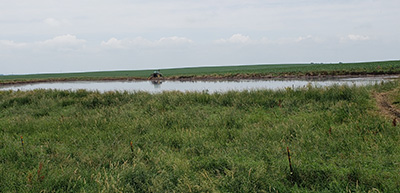Effective runoff management for open lots and outdoor manure storages during wet weather
7/10/24
AMES, Iowa – Many areas of Iowa have experienced higher than average precipitation events with a string of continued wet weather. This abnormally wet weather pattern has caused drainage and flooding issues in the states. During wet weather patterns, farmers must be vigilant in monitoring storage levels of runoff holding ponds and out-of-barn manure.
Runoff occurs when rainfall flows over the land surface instead of infiltrating the ground. This runoff can pick up and transport pollutants in agricultural settings, particularly in open lots, including nutrients (nitrogen and phosphorus), pathogens, and organic matter. These pollutants can contaminate surface water bodies, causing algal blooms, fish kills, and degradation of aquatic ecosystems. Catching and treating this water is critical. Feedlot runoff and manure contain high levels of ammoniacal nitrogen, which is toxic to fish. Ammoniacal nitrogen is strongly absorbed by soil, so management practices that encourage manure or feedlot runoff contact with soil rather than flow over the soil significantly reduce the risk of nutrient movement.
Managing runoff from open lots and outdoor manure storages during wet weather is crucial for protecting water quality, public health, and the environment. Wet weather exacerbates the potential for nutrient and pathogen runoff by increasing the runoff volume and stressing the holding capacity of manure and runoff storage. Effective runoff management practices can mitigate these risks, ensuring sustainable agricultural operation and environmental stewardship.
The number one goal of management must be preventing a holding pond or manure storage from overflowing. Over-topping earthen berms may compromise manure storage and lead to catastrophic discharge. Similarly, while ideal land application conditions don’t exist, effluent discharge from the manure or runoff control pond will be most concentrated and most likely to lead to fish kills if it enters a water body. Application to wet soils is preferable compared to allowing a storage basin overflow.
When applying to wet soils, vegetated areas such as pasture or hay are preferred to better support equipment and reduce runoff potential. Use land with the least potential for runoff and lower slopes to give time for effluent to soak into the soils. Increase separation distances where possible and selectively apply to fields to avoid wet spots. Pumping operations should be monitored continuously to watch for signs of runoff, and applications should be stopped if signs of runoff develop.
Critical strategies for runoff management
Evaluate buffer zones and diversion channels. Diversion channels or berms divert clean water away from manure storage areas. Prolonged wet periods can cause diversions to lose shape and effectiveness. Please take a moment to check them over at your farm to minimize the amount of water you are dealing with. Establish vegetative buffer zones around open lots and manure storages to filter and absorb runoff. Grasses can trap sediments and uptake nutrients before they reach water bodies; perennial roots help increase absorption in the soil to minimize flow if overflows occur.
Feedlot surface. When possible, scrape lots to maintain a 3-5% slope away from feed bunks and toward drainage collection areas. Reshape mounds to ensure water runs away from mounds quickly to provide good animal resting areas—repair problem areas, especially around the concrete pad along the feed buck. Evaluate fence lines and clear debris if it becomes an obstacle to obtaining good drainage from the pen surface.
Settling basins and retention ponds. Settling basins help remove solids from runoff water before they enter the runoff retention pond. Most settling basins are designed to have solids removed after significant rainfall events. Remove solids from the settling basin and check the slotted gate or perforated pipe to ensure slots aren’t plugged, and water is directed through the settling basin outlet. Evaluate how full the retention pond or manure storage is and plan to remove some manure to ensure sufficient storage volumes to make it too full. If required, ensure manure application areas are included in your manure or nutrient management plan.
Effective runoff management from open lots and outdoor manure storages during wet weather is vital for protecting water quality and promoting sustainable agricultural practices. By combining site selection, structural and vegetative practices, and nutrient management, farms can mitigate the risks associated with runoff. Continuous monitoring and maintenance are essential to ensure the long-term success of these strategies, ultimately benefiting both the environment and agricultural operations.
-30-
The Iowa Beef Center at Iowa State University was established in 1996 with the goal of supporting the growth and vitality of the state’s beef cattle industry. It comprises faculty and staff from Iowa State University Extension and Outreach, College of Agriculture and Life Sciences and College of Veterinary Medicine, and works to develop and deliver the latest research-based information regarding the beef cattle industry. For more information about IBC, visit www.iowabeefcenter.org.
Contact:
Dan Andersen, ISU ag and biosystems engineering, 515-294-4210, dsa@iastate.edu

